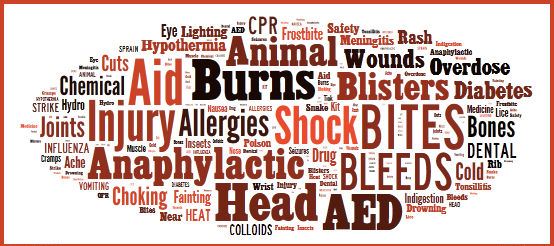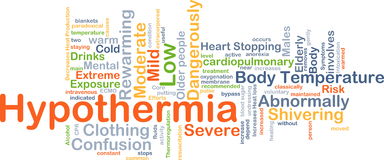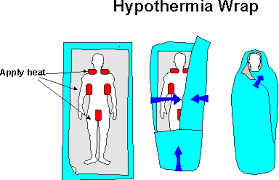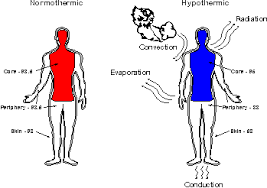
Contents
First aid – Hypothermia
Over view:
Hypothermia happens when someone’s body temperature drops below 35°C (95°F). Normal body temperature is around 37°C (98. 6°F).
Hypothermia can become life-threatening quickly, so it’s important to treat someone with hypothermia straight away. Severe hypothermia, when the body temperature falls below 30°C (86°F), is often fatal.
When your body temperature drops, your heart, nervous system and other organs can’t work normally. Left untreated, hypothermia can eventually lead to complete failure of your heart and respiratory system and to death.
Hypothermia is usually caused by being in a cold environment for a long time. This could be from staying outdoors in cold conditions, falling into cold water, or from living in a poorly heated house. Elderly people, babies, homeless people and anyone who is thin and frail or not able to move around easily are particularly vulnerable.
Shivering is likely the first thing you’ll notice as the temperature starts to drop because it’s your body’s automatic defense against cold temperature — an attempt to warm itself.
Alternative Names:
Low body temperature; Cold exposure
Hypothermia Causes:
Normal body temperature is the reflection of a delicate balance between heat production and heat loss. Many of the chemical reactions necessary for human survival can occur only in specific temperature ranges. The human brain has a number of ways to maintain vital temperature. When these mechanisms are overwhelmed, heat loss happens faster than heat production, which results in hypothermia.
Primary hypothermia is due to exposure to a cold or frigid environment, with no underlying medical condition, causing disruption in temperature regulation:
Sometimes the body’s temperature control can be altered by disease. In this case, core body temperature can decrease in almost any environment. This condition is called secondary hypothermia. In secondary hypothermia, something goes wrong with the body’s heat-balancing mechanisms.
Signs and symptoms:

Mild hypothermia include:
- Shivering
- Dizziness
- Hunger
- Nausea
- Faster breathing
- Trouble speaking
- Slight confusion
- Lack of coordination
- Fatigue
- Increased heart rate
Moderate to severe hypothermia signs:
As your body temperature drops, signs and symptoms of moderate to severe hypothermia include:
- Shivering, although as hypothermia worsens, shivering stop.

- Clumsiness or lack of coordination
- Slurred speech or mumbling
- Confusion and poor decision-making, such as trying to remove warm clothes
- Drowsiness or very low energy
- Lack of concern about one’s condition
- Progressive loss of consciousness
- Weak pulse
- Slow, shallow breathing
Someone with hypothermia usually isn’t aware of his or her condition because the symptoms often begin gradually. Also, the confused thinking associated with hypothermia prevents self-awareness. The confused thinking can also lead to risk-taking behavior.
Hypothermia in infants:![]()
Typical signs of hypothermia in an infant include:
- Bright red, cold skin
- Very low energy
- A weak cry
When to see a doctor:
Call emergency or your local emergency number if you see someone with signs of hypothermia or if you suspect a person has had unprotected or prolonged exposure to cold weather or water.
If possible take the person inside, moving them carefully and slowly. Jarring movements can trigger dangerous irregular heartbeats. Carefully remove wet clothing, and cover him or her in layers of blankets while you wait for emergency help to arrive.
Hypothermia occurs when your body loses heat faster than it produces it. The most common causes of hypothermia are exposure to cold-weather conditions or cold water. But prolonged exposure to any environment colder than your body can lead to hypothermia if you aren’t dressed appropriately or can’t control the conditions.
Specific conditions leading to hypothermia include:
- Wearing clothes that aren’t warm enough for weather conditions.
- Staying out in the cold too long.
- Unable to get out of wet clothes or move to a warm, dry location.
- Accidental falls in water, as in a boating accident.
- Inadequate heating in the home, especially for older people and infants.
- Air conditioning that is too cold, especially for older people and infants.
First-aid care![]()
- Be gentle. When you’re helping a person with hypothermia, handle him or her gently. Limit movements to only those that are necessary. Don’t massage or rub the person. Excessive, vigorous or jarring movements may trigger cardiac arrest.
- Move the person out of the cold. Move the person to a warm, dry location if possible. If you’re unable to move the person out of the cold, shield him or her from the cold and wind as much as possible.
- Remove wet clothing. If the person is wearing wet clothing, remove it. Cut away clothing if necessary to avoid excessive movement.
- Cover the person with blankets. Use layers of dry blankets or coats to warm the person. Cover the person’s head, leaving only the face exposed.
- Insulate the person’s body from the cold ground. If you’re outside, lay the person on his or her back on a blanket or other warm surface.
- Monitor breathing. A person with severe hypothermia may appear unconscious, with no apparent signs of a pulse or breathing. If the person’s breathing has stopped or appears dangerously low or shallow, begin CPR immediately if you’re trained.
- Share body heat. To warm the person’s body, remove your clothing and lie next to the person, making skin-to-skin contact. Then cover both of your bodies with blankets.
- Provide warm beverages. If the affected person is alert and able to swallow, provide a warm, sweet, nonalcoholic, non caffeinated beverage to help warm the body.
- Use warm, dry compresses. Use a first-aid warm compress (a plastic fluid-filled bag that warms up when squeezed) or a makeshift compress of warm water in a plastic bottle or a dryer-warmed towel. Apply a compress only to the neck, chest wall or groin.Don’t apply a warm compress to the arms or legs. Heat applied to the arms and legs forces cold blood back toward the heart, lungs and brain, causing the core body temperature to drop. This can be fatal.
- Don’t apply direct heat. Don’t use hot water, a heating pad or a heating lamp to warm the person. The extreme heat can damage the skin or, even worse, cause irregular heartbeats so severe that they can cause the heart to stop.

Staying warm in cold weather:
Before you or your children step out into cold air, remember the advice that follows with the simple acronym COLD — cover, over exertion, layers, dry:
- Cover. Wear a hat or other protective covering to prevent body heat from escaping from your head, face and neck. Cover your hands with mittens instead of gloves. Mittens are more effective than gloves because mittens keep your fingers in closer contact.
- Overexertion. Avoid activities that would cause you to sweat a lot. The combination of wet clothing and cold weather can cause you to lose body heat more quickly.
- Layers. Wear loose fitting, layered, lightweight clothing. Outer clothing made of tightly woven, water-repellent material is best for wind protection. Wool, silk or polypropylene inner layers hold body heat better than cotton does.
- Dry. Stay as dry as possible. Get out of wet clothing as soon as possible. Be especially careful to keep your hands and feet dry, as it’s easy for snow to get into mittens and boots.
Keeping children safe outdoors:
To help prevent hypothermia when children are outside in the winter:
- Dress infants and young children in one more layer than an adult would wear in the same conditions.
- Bring children indoors if they start shivering — that’s the first sign that hypothermia is starting.
- Have children come inside frequently to warm themselves when they’re playing outside.
- Don’t let babies sleep in a cold room.
How Do I Stay Safe?
- Try to stay away from cold places. Changes in your body that come with aging can make it harder for you to be aware of getting cold.
- You may not always be able to warm yourself. Pay attention to how cold it is where you are.
- Check the weather forecasts for windy and cold weather. Try to stay inside or in a warm place on cold and windy days. If you have to go out, wear warm clothes including a hat and gloves. A waterproof coat or jacket can help you stay warm if it’s cold and snowy.
- Wear several layers of loose clothing when it’s cold. The layers will trap warm air between them. Don’t wear tight clothing because it can keep your blood from flowing freely. This can lead to loss of body heat.
- Ask your doctor how the medicines you are taking affect body heat. Some medicines used by older people can increase the risk of accidental hypothermia. These include drugs used to treat anxiety, depression, or nausea. Some over-the-counter cold remedies can also cause problems.
- When the temperature has dropped, drink alcohol moderately, if at all. Alcoholic drinks can make you lose body heat.
- Make sure you eat enough food to keep up your weight. If you don’t eat well, you might have less fat under your skin. Body fat helps you to stay warm.
Staying Warm Inside:
Being in a cold building can also cause hypothermia. In fact, hypothermia can happen to someone in a nursing home or group facility if the rooms are not kept warm enough. People who are already sick may have special problems keeping warm. If someone you know is in a group facility, pay attention to the inside temperature and to whether that person is dressed warmly enough.
Even if you keep your temperature between 60 °F and 65 °F, your home or apartment may not be warm enough to keep you safe. For some people, this temperature can contribute to hypothermia. This is a special problem if you live alone because there is no one else to feel the chilliness of the house or notice if you are having symptoms of hypothermia. Set your thermostat for at least 68 °F to 70 °F. If a power outage leaves you without heat, try to stay with a relative or friend.
You may be tempted to warm your room with a space heater. But, some space heaters are fire hazards, and others can cause carbon monoxide poisoning. The Consumer Product Safety Commission has information on the use of space heaters, but here are a few things to keep in mind:
- Make sure your space heater has been approved by a recognized testing laboratory.
- Choose the right size heater for the space you are heating.
- Put the heater on a flat, level surface that will not burn.
- Keep children and pets away from the heating element.
- Keep things that can catch fire like paint, clothing, bedding, curtains, and papers away from the heating element.
- If your heater has a flame, keep a window open at least one-inch and doors open to the rest of your home for good air flow.
- Turn the heater off when you leave the room or go to bed.
- Make sure your smoke alarms are working.
- Put a carbon monoxide detector near where people sleep.
- Keep an approved fire extinguisher nearby.
Cold-water safety:
Water doesn’t have to be extremely cold to cause hypothermia. Any water that’s colder than normal body temperature causes heat loss. The following tips may increase your survival time in cold water if you accidentally fall in:
- Wear a life jacket. If you plan to ride in a watercraft, wear a life jacket. A life jacket can help you stay alive longer in cold water by enabling you to float without using energy and by providing some insulation. Keep a whistle attached to your life jacket to signal for help.
- Get out of the water if possible. Get out of the water as much as possible, such as climbing onto a capsized boat or grabbing onto a floating object.
- Don’t attempt to swim unless you’re close to safety. Unless a boat, another person or a life jacket is close by, stay put. Swimming will use up energy and may shorten survival time.
- Position your body to minimize heat loss. Use a body position known as the heat escape lessening position (HELP) to reduce heat loss while you wait for assistance. Hold your knees to your chest to protect the trunk of your body. If you’re wearing a life jacket that turns your face down in this position, bring your legs tightly together, your arms to your sides and your head back.
- Huddle with others. If you’ve fallen into cold water with other people, keep warm by facing each other in a tight circle.
- Don’t remove your clothing. While you’re in the water, don’t remove clothing because it helps to insulate you from the water. Buckle, button and zip up your clothes. Cover your head if possible. Remove clothing only after you’re safely out of the water and can take measures to get dry and warm.
Hypothermia Prevention:![]()
Prepare well before embarking on any cold weather activities.
- Be aware of the environmental conditions you will encounter.
- Make sure people are conditioned physically and have adequate nutrition and rest.
- Travel with a partner.
- Wear multiple layers of clothing, loosely fitted. Cover the head, wrists, neck, hands, and feet and try to remain dry; wool, silk or polypropylene layered clothing is better than cotton clothing.
- In an emergency, drink cold water rather than ice or snow.
- Be wary of wind and wet weather because they increase the rate of heat loss.
- Keep the homes of the elderly heated to at least 70 F (21.1 C), especially the sleeping area.
Wear proper clothing in cold temperatures to protect your body. These include:
- Mittens (not gloves)
- Wind-proof, water-resistant, many-layered clothing
- Two pairs of socks (avoid cotton)
- Scarf and hat that cover the ears (to avoid major heat loss through the top of your head)
Avoid:
- Extremely cold temperature, especially with high winds
- Wet clothes
- Poor circulation, which is more likely from age, tight clothing or boots, cramped positions, fatigue, certain medications, smoking, and alcohol
DO NOT
- Do NOT assume that someone found lying motionless in the cold is already dead.
- Do NOT use direct heat (such as hot water, a heating pad, or a heat lamp) to warm the person.
- Do NOT give the person alcohol!
First aid video for Hypothermia -1
First aid video for Hypothermia -2
